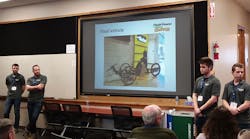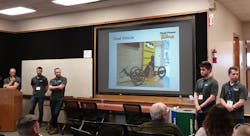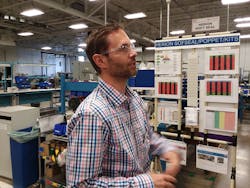This is the last of a three-part series dedicated to drawing employers’ attention to people in the process of becoming passionate about fluid power.
Click here to view Part 1—Making Fun of Fluid Power
Click here to view Part 2—Hunting Heads. . .at the NFPA’s Fluid Power Vehicle Challenge
One of the most important things students competing in the NFPA’s Fluid Power Vehicle Challenge learned was, teams of specialists don’t do very well. The competition, held at the IMI Precision Engineering facility in Littleton, Colo. this year, attracted teams from 15 universities across the country. Although that lesson could have come from a seasoned professional of any industry, it just happened to come from Kent Sowatzke, VP of engineering at Bimba.
“The students who work together the whole way to understand the electronics, the shifting portion of the valve, designing the structural portion of the frame, understanding how the circuit works—theirs are the teams that do the best,” he told H&P. “The teams who don’t do that may have a working vehicle at the end, but it’s not as good. A good engineer is one who can sell. You’re either selling your design, your idea, or yourself.”
A Winning Design
The team presentation of this year’s winner, Cleveland State University, proved Sowatzke’s point. In fact, after seeing the team come together to tell how their vehicle came together, industry recruiter Ernie Parker said there was one member in particular he’d hire tomorrow if he could. H&P won’t tell you which one he had his eye on, but we will summarize the components of this winning team’s presentation.
During their pre-competition presentation, the Cleveland State team explained how they redesigned their vehicle’s gear ratio for easier pedaling (from 1:7 to 1:10) because the rider is in front rather than on top.
Before talking about the final design, there were elements they had to redesign at certain points: the welds, the pedaling angle, the steering arm, and the accumulator stand. “It was pretty challenging attaching a 2½-gallon accumulator to a two-wheel bike,” one student said.
They ended up with a three-wheel design. They also had to redesign the gear ratio for pedaling— from 1:7 to 1:10 because the rider is in front rather than on top. The fluid was channeled through a pedaling circuit, a charging circuit, and a discharging circuit. The team experimented with pull valves but ultimately went with ball valves.
But by mid-term in the Challenge, this team still had a long way to go toward a final product. Big items yet to be accomplished, included designing the gearing, so they could shift up to three different gears to make their sprint time more efficient. They’d have an easier start, then be able to switch to a higher gear as they increased speed, they calculated. They had difficulty with sprocket engagement because the chain stretched and skipped teeth. A slight redesign enabled them to increase tooth engagement significantly and charge the accumulator more smoothly.
“Our main improvements were increasing the back end gear ratio, fixing the motor orientation, reducing the number of fittings and friction losses, improving alignment of bearing housings, all while improving mechanical efficiency,” the team concluded. “Climbing through gears one through three versus just starting at gear three gives a great sprint time. Although there’s a slower acceleration from the start, we can maintain acceleration for a longer time, whereas just using gear three from the start would result in a higher speed that dissipates quickly.”
For the circuit design, the team moved the pump so it would be most efficient. They found they could improve times and speeds just by cutting efficiency losses. “Minimizing all our friction losses with the fittings was a huge thing for us,” a team member explained. The team also decided to go with a piston pump instead of a gear pump because of the piston pump’s higher efficiency.
All that said, Cleveland State still couldn’t find a way to make a less-expensive hydraulic bike, and Kent Sowatzke admits that’s not the goal of this competition.
“This is more of a teaching competition—giving students a challenge and letting them work on it,” he says. “The big thing is that it teaches them energy harvesting, which can be used in other industries. One of the benefits of hydraulics is that it can store energy. So can pneumatics, but you can achieve higher pressures with hydraulics. However, when pneumatic connections break free, you get a big bang. With hydraulics, you get a big leak. That would have to be addressed if we were to put pneumatics on a vehicle someone is sitting on. We’d have to make sure pressures don’t exceed 50 psi. Students may think a big bang would be cool, but I wouldn’t want to be near it.”
Lessons Learned About Accumulators
“Once you pressurize the accumulator then start to pedal the bike, some backpressure in the system would actually force the pull valve to unseat itself and you would start dispersing accumulator pressure unintentionally,” a team member explained. “That’s why we went back to the ball valve.”
The team decided it needed a flow-control valve in case it needed to safely discharge the accumulator to the reservoir without turning the back wheel back. The 2½-gallon carbon fiber accumulator represented a big increase from the quart accumulator their school’s team used in last year’s competition.
The Hydraulic Vehicle Challenge’s overall champions, Cleveland State, also won the Best Design and the Sprint Race categories. The team went from a two-wheel to a three-wheel design, requiring a redesign of the welds, the pedaling angle, the steering arm, and the accumulator stand.
“We calculated the potential energy in our accumulator. We also calculated the kinetic energy the accumulator would discharge, and we talked about the power needed to make our bike move at certain speeds,” another team member explained. “We estimated our sprint time at 25 mph so we knew we’d go 600 ft in 25 sec. With a 1,000 psi precharge, we estimated our travel with a 2½-gallon accumulator to be 3,660 ft.”
The team also learned a few valuable lessons about accumulators. They discovered that as they reduced the precharge pressure, their scores increased. A problem occurred with that precharge decrease, however. The reservoir held about 2.7 gallons of fluid, but with 1,000 psi in the accumulator, it took in about 1.8 gallons of fluid that gradually increased as precharge decreased. The reservoir ran out of fluid with that large decrease in precharge. Reducing initial precharge pressure and adding fluid in the accumulator gave them a longer dispersal of energy, which would help in the endurance race.
Vertical Integration Works
Cleveland State ultimately proved in the short term what IMI Precision Engineering intends to prove in the long run of its current five-year plan: the importance of becoming vertically integrated. Tim Williams, general manager of the IMI Precision Engineering plant in Littleton—the site of this year’s hydraulic vehicle competition—gave visitors a tour of his operations. What was evident among the better student teams was on display in the various IMI operations visitors saw on the plant’s 240,000-sq-ft floor.
Tim Williams, general manager of the IMI Precision Engineering plant in Littleton, Colo.
“In our industry, we’re seeing a trend away from outsourcing and toward vertical integration,” Williams says. “Being more vertically integrated, you’re more agile and can get to market quicker. Culture is the biggest challenge. Building momentum for vertical integration requires building self-managed teams. The students in this competition are involved in a mini-version of that, with the requisite cooperation and teamwork. They’re learning you can’t do everything by yourself.”
Sizing Up the Students
Although Kent Sowatzke said none of the officials wanted to be around any unintended big bangs among the entries, what he and many talent-hunting industry representatives wanted to be near was these students as they made their discoveries.
The teams that do best with the judges in this competition focus on their strengths in specific judging criteria, such as endurance and efficiency.
“Students are no different from customers,” Sowatzke explains. “Our customers give us insights into how they are thinking and applying our stuff. We may learn something about how our catalogs are written or how we’re presenting ourselves in the marketplace—about how we can do this better.”
The Purdue University Northwest team had to extend the frame of its bike 6 in. to make room for the regen pump and to keep the accumulator in an upright position. All of this customization caused the judges to recognize this team for “Best Workmanship.”
What you can and should be doing while learning to function in a team environment is learning how this makes you a stronger individual job candidate, says Amr Semmami, a mechanical engineer at Certified Power Solutions, Burnsville, Minn. Semmami proved this by advancing from a participant in last year’s competition on the West Virginia University Institute of Technology team to his current full-time position. How did that happen?
“[Event sponsor] Danfoss had engineers available at all times and they provided some great networking opportunities during the competition,” Semmami told H&P. He believes that what students should do to take best advantage of such an opportunity is ask yourself the following:
Did you enter this competition with a strategy?
Is your team proficient in any of the specific judging criteria like endurance and efficiency?
Are you doing anything with pneumatics or incorporating a manifold?
What have you learned about energy efficiency, and how important was energy efficiency to your team?
Has your school participated in past competitions? If so, what did you do differently or improve upon? If not, what were your primary goals and what will you improve on next year?
Were you frustrated by some of the design constraints? (Are there things you would have liked to design in but weren’t allowed to?)
What are some of the most important things you learned beyond fluid power?
Not a bad set of questions to prepare for any new opportunity in fluid power.
2019 NFPA Fluid Power Vehicle Challenge Winners
Overall Champion—Cleveland State University
2nd Place—California Polytechnic State University at San Luis Obispo
3rd Place—Western Michigan University
Sprint Race—Cleveland State University
Efficiency Challenge—Western Michigan University
Endurance Challenge—California Polytechnic State University at San Luis Obispo
Best Presentations—Cleveland State University
Best Design (voted on by the students)—Cleveland State University
Best Teamwork—Iowa State University
Rookie of the Year—Montana State University
Best Reliability and Safety—University of Cincinnati
Best Workmanship—Purdue University Northwest







